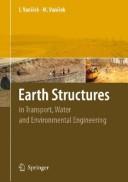| Listing 1 - 4 of 4 |
Sort by
|

ISBN: 1281378100 9786611378103 1615833749 1402039646 1402039638 9048170036 Year: 2008 Publisher: Dordrecht : Springer Netherlands : Imprint: Springer,
Abstract | Keywords | Export | Availability | Bookmark
 Loading...
Loading...Choose an application
- Reference Manager
- EndNote
- RefWorks (Direct export to RefWorks)
While soil is the oldest, most commonly used building material, there is a paradox in that the subject of Earth Structures has never previously been comprehensively covered. This book describes the principles of working with soil as a construction material, including two basic ways of treating it: geosynthetics and stabilization. The book discusses the design logic and ways to control Earth Structures, which differ significantly from other construction materials. Building with Earth involves greater uncertainty and risk, which means that there is a need for better design detailing and improvement in the quality of financial calculations. The general part of the book gives a detailed description of the principles of limit states according to Eurocode 7, after which geotechnical design is also described. Subsequent chapters concentrate on earth structures for transport, water, and environmental projects. The chapter on Earth Structures in transport engineering presents detailed coverage of limit states of stability and deformation. Earth Structures in water engineering prioritizes the limit state of internal erosion. Earth Structures in environmental engineering describes new designs, in which part of the structure is created from non-standard materials which are usually susceptible to internal collapse, double porosity, unsaturation, etc. It also focuses on protecting the surrounding environment from contamination. With its emphasis on principles, the logic of processes, and understanding the most important problems, the book allows all those involved with a construction (client, designer, contractor and supervisor) to build such earth structures more safely and economically. Audience: This book will be of interest to civil and environmental engineers; transport, hydraulic and planning engineers; geotechnical and geo-environmental engineers; scientists, designers, contractors, clients and supervisors; postgraduate students.
Soil mechanics. --- Engineering. --- Construction --- Industrial arts --- Technology --- Soil engineering --- Soils --- Soils (Engineering) --- Geotechnical engineering --- Mechanics --- Foundations --- Soil physics --- Hydraulic engineering. --- Civil engineering. --- Waste disposal. --- Geotechnical Engineering & Applied Earth Sciences. --- Geoengineering, Foundations, Hydraulics. --- Civil Engineering. --- Waste Management/Waste Technology. --- Engineering --- Public works --- Engineering, Hydraulic --- Fluid mechanics --- Hydraulics --- Shore protection --- Geotechnical engineering. --- Engineering geology. --- Engineering—Geology. --- Foundations. --- Hydraulics. --- Waste management. --- Flow of water --- Water --- Hydraulic engineering --- Jets --- Architecture --- Building --- Structural engineering --- Underground construction --- Caissons --- Earthwork --- Masonry --- Soil consolidation --- Soil mechanics --- Walls --- Civil engineering --- Geology, Economic --- Engineering, Geotechnical --- Geotechnics --- Geotechnology --- Engineering geology --- Flow --- Distribution --- Details --- Geology

ISBN: 9781402039645 Year: 2008 Publisher: Dordrecht Springer Science+Business Media B.V
Abstract | Keywords | Export | Availability | Bookmark
 Loading...
Loading...Choose an application
- Reference Manager
- EndNote
- RefWorks (Direct export to RefWorks)

ISBN: 9781402039645 Year: 2008 Publisher: Dordrecht Springer Netherlands
Abstract | Keywords | Export | Availability | Bookmark
 Loading...
Loading...Choose an application
- Reference Manager
- EndNote
- RefWorks (Direct export to RefWorks)
While soil is the oldest, most commonly used building material, there is a paradox in that the subject of Earth Structures has never previously been comprehensively covered. This book describes the principles of working with soil as a construction material, including two basic ways of treating it: geosynthetics and stabilization. The book discusses the design logic and ways to control Earth Structures, which differ significantly from other construction materials. Building with Earth involves greater uncertainty and risk, which means that there is a need for better design detailing and improvement in the quality of financial calculations. The general part of the book gives a detailed description of the principles of limit states according to Eurocode 7, after which geotechnical design is also described. Subsequent chapters concentrate on earth structures for transport, water, and environmental projects. The chapter on Earth Structures in transport engineering presents detailed coverage of limit states of stability and deformation. Earth Structures in water engineering prioritizes the limit state of internal erosion. Earth Structures in environmental engineering describes new designs, in which part of the structure is created from non-standard materials which are usually susceptible to internal collapse, double porosity, unsaturation, etc. It also focuses on protecting the surrounding environment from contamination. With its emphasis on principles, the logic of processes, and understanding the most important problems, the book allows all those involved with a construction (client, designer, contractor and supervisor) to build such earth structures more safely and economically. Audience: This book will be of interest to civil and environmental engineers; transport, hydraulic and planning engineers; geotechnical and geo-environmental engineers; scientists, designers, contractors, clients and supervisors; postgraduate students.
Book
ISBN: 9780367546038 9780367208349 0367546035 0367208342 Year: 2020 Publisher: Boca Raton: CRC,
Abstract | Keywords | Export | Availability | Bookmark
 Loading...
Loading...Choose an application
- Reference Manager
- EndNote
- RefWorks (Direct export to RefWorks)
"Technical demands have to be adequately related to the risk with which the design and execution are connected. Soil used for the construction, together with subsoil, are natural materials with a high degree of inhomogeneity. Therefore, the risk when constructing with such materials is much higher than for structures utilizing man-made materials. This book will be of interest to specialists responsible for transport infrastructure planning, investors (project owners) of motorways and railways and environmental engineers, responsible for geotechnical investigations, earth structures design and on contractors of such structures."
Soil mechanics --- Geotechnical engineering --- Transportation engineering --- Sustainability
| Listing 1 - 4 of 4 |
Sort by
|

 Search
Search Feedback
Feedback About
About Help
Help News
News